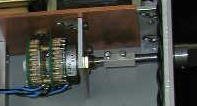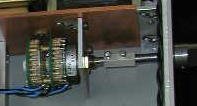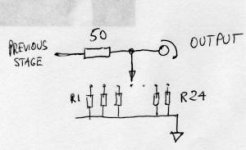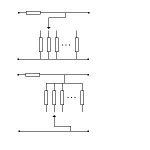The only problem with non-linear taper is that they
don't tend to track as well between channels.
🙁
don't tend to track as well between channels.
🙁
NP: May I ask why you weren't happy with your Electroswitch's. Are you referring to the "flat" vertical pcb mount design? I ask because I was about to go that route myself. I've been looking for a good pcb mounted, many-position-switch, so I could make up a sort of "universal" pcb.
Sourcing good pots is right behind sourcing heatsinks when it comes to the "pain" factor.
Thanks
Mike
Sourcing good pots is right behind sourcing heatsinks when it comes to the "pain" factor.
Thanks
Mike
I am sure everybody knows Elma (http://www.elma.ch/) but they make decent switches and the type 4 is available in 4-gang/24-position/gold-plated. Price is about USD 120 (CHF 200) at qty 1 here in Switzerland. That is a shorting switch which is used quite often as shunt attenuator in it's 2-gang version.
04-4133 is the part number. This is the one I think I will be using with 0.1 % matched Welwyn resistors in my P1.7 remembering Nelson's comments on CMRR when pot is out of track. However I will cheat a little and fit a suitable normal pot at the output and adjust the volume in steps I find good. I will measure the pot for each of the steps and then fix the values for the stepped attenuator not thinking about proper LOG or audio taper which I am sure is not what would fit perfectly anyways.
Thel (http://www.thel.de/) sells silver/carbon potentiometers that are 6-gang. They also sell gears that will resemble the set-up mentioned previously where 2 pots where controlled with one knob.
/UrSv
04-4133 is the part number. This is the one I think I will be using with 0.1 % matched Welwyn resistors in my P1.7 remembering Nelson's comments on CMRR when pot is out of track. However I will cheat a little and fit a suitable normal pot at the output and adjust the volume in steps I find good. I will measure the pot for each of the steps and then fix the values for the stepped attenuator not thinking about proper LOG or audio taper which I am sure is not what would fit perfectly anyways.
Thel (http://www.thel.de/) sells silver/carbon potentiometers that are 6-gang. They also sell gears that will resemble the set-up mentioned previously where 2 pots where controlled with one knob.
/UrSv
I'm using Elma type 4, 2 gang switch at the output of my DAC. Besides slight noise when switching, I'm quite happy with it. There are two versions of that switch, this is the better one, with improved contacts. There is one series resistor in 50 ohm value and I'm only switching shunt resistors which range from 500 to 0.5 ohm. This assures very low output impedance. If there is an interest I can post the values.😉
Attachments
Peter,
Please post your values if you have them.
As for your question about the size of the inner gear affecting the resistance to turn the pot (assuming we are talking force needed and not the resistance of the pot itself but I take that for granted since you were the one who asked) it certainly does. The smaller the inner gear the smaller the force needed and vice versa. It should be reasonably linear and an inner gear half the diameter of the outer gear would mean that you would only need half the force compared to direct connection (or the same as before if the gears are running two pots/switches). This of course using provided that you use the same knob in all cases...
but I take that for granted since you were the one who asked) it certainly does. The smaller the inner gear the smaller the force needed and vice versa. It should be reasonably linear and an inner gear half the diameter of the outer gear would mean that you would only need half the force compared to direct connection (or the same as before if the gears are running two pots/switches). This of course using provided that you use the same knob in all cases...
/UrSv
Please post your values if you have them.
As for your question about the size of the inner gear affecting the resistance to turn the pot (assuming we are talking force needed and not the resistance of the pot itself
 but I take that for granted since you were the one who asked) it certainly does. The smaller the inner gear the smaller the force needed and vice versa. It should be reasonably linear and an inner gear half the diameter of the outer gear would mean that you would only need half the force compared to direct connection (or the same as before if the gears are running two pots/switches). This of course using provided that you use the same knob in all cases...
but I take that for granted since you were the one who asked) it certainly does. The smaller the inner gear the smaller the force needed and vice versa. It should be reasonably linear and an inner gear half the diameter of the outer gear would mean that you would only need half the force compared to direct connection (or the same as before if the gears are running two pots/switches). This of course using provided that you use the same knob in all cases.../UrSv
Elma
Also using Elma type 4 switches in my gear. If you are in the USA, you can order directly from their facility in Fremont, CA. Double bonus if you live in the San Francisco Bay Area.
I wonder where Arn Roatcap (http://www.goldpt.com/) gets Elma type 4 switches with 6 decks?
Also using Elma type 4 switches in my gear. If you are in the USA, you can order directly from their facility in Fremont, CA. Double bonus if you live in the San Francisco Bay Area.
I wonder where Arn Roatcap (http://www.goldpt.com/) gets Elma type 4 switches with 6 decks?
UrSv said:
As for your question about the size of the inner gear affecting the resistance to turn the pot (assuming we are talking force needed and not the resistance of the pot itselfbut I take that for granted since you were the one who asked) it certainly does. The smaller the inner gear the smaller the force needed and vice versa. It should be reasonably linear and an inner gear half the diameter of the outer gear would mean that you would only need half the force compared to direct connection (or the same as before if the gears are running two pots/switches). This of course using provided that you use the same knob in all cases...
/UrSv
Sorry, UrSv, but this is not the case. That would be valid if we are building a train of gears, with the aim to exchange torque for speed, or vice-versa. In our case whatever dimension the central gear is, the force needed for turning both pots is always the same. The central gear has only to connect the two pots. The overral (phisical) resistence is just the sum of the two pots, providing that whatever gear is in between has a negligible resistance of it's own, but whatever it is depends only by it's friction. Passing from the gear we are turning (the one connected to the right pot) to the central one we are speeding it up, exchanging torque for speed. In turn, the small one connected to the gear on the left exchange speed for torque. The balance is even. Since the smaller the central one the faster it turns, we have only to worry about friction.

Roberto Amato
Elma makes them any way you wish with even 7 decks or more.
They are however not standard but custom order...
/UrSv
They are however not standard but custom order...
/UrSv
Roberto, Peter,
Sorry for not checking the picture closely enough. I assumed that the control of the set-up would be done thorugh center gear (in which case my statement is true) which I see it is not. Obviously then the size is transparent to the user and the force is sum of all the individual forces for pots/switches. Did not mean to be confusing...
/UrSv
Sorry for not checking the picture closely enough. I assumed that the control of the set-up would be done thorugh center gear (in which case my statement is true) which I see it is not. Obviously then the size is transparent to the user and the force is sum of all the individual forces for pots/switches. Did not mean to be confusing...

/UrSv
Does anyone have plans for physical construction of attenuator in which resistors from peters table can be used? how did you do it peter?
Peter,
It looks to me as if the attenuation values you posted are for a 500 ohm series resistor not a 50 ohm.
It looks to me as if the attenuation values you posted are for a 500 ohm series resistor not a 50 ohm.
I see now🙂 Didnt looked at that pic closely before.. Attenuator on this pic is for 1 balanced ch. only?
Does anybody know which is preferable (if useful at all in bottom version) of the different versions below? I read something about having the switch as close to ground as possible but in this case it seems maybe a lot of stray capacitance would be added?
/UrSv
/UrSv
Attachments
UrSv
I would go with a top one, somehow I don't like the idea of so many resistors hanging from the output.
Skaara
It's stereo, I'm not using balanced output there.
I would go with a top one, somehow I don't like the idea of so many resistors hanging from the output.
Skaara
It's stereo, I'm not using balanced output there.
Peter,
doesn't the type of connection vary the output impedance of the circuit? I don't know if I like that.
Also I was wondering what would happen if you put a 5k fixed resistor to ground after the 50 Ohm as a way of getting rid of the switching noise. The log curve would be changed but that should be about it.
doesn't the type of connection vary the output impedance of the circuit? I don't know if I like that.
Also I was wondering what would happen if you put a 5k fixed resistor to ground after the 50 Ohm as a way of getting rid of the switching noise. The log curve would be changed but that should be about it.
- Status
- Not open for further replies.
- Home
- Amplifiers
- Pass Labs
- balanced volume control




